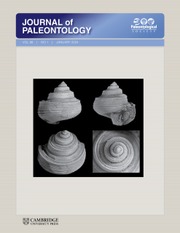No CrossRef data available.
Article contents
New species of noncalcified dasycladalean and bryopsidalean macroalgae and a new occurrence of Thalassocystis striata (Chlorophyta) from the Silurian (Llandoverian) of Michigan
Published online by Cambridge University Press: 20 August 2025
Abstract
The Llandoverian (Telychian) Schoolcraft Formation of Schoolcraft County in the Upper Peninsula of Michigan includes several intervals of exceptional preservation marked by abundant specimens of the noncalcified macroalga Thalassocystis striata Taggart and Parker, 1976. Here, two new noncalcified macroalgal species are described from one of these algal-Lagerstätten intervals. The monopodial thallus of Archaeobatophora gulliverensis new species resembles that of the living dasycladalean green alga Batophora Agardh, 1854 and consists of a cylindrical main axis bearing whorls of branched laterals. It is the second species to be assigned to Archaeobatophora Nitecki, 1976, the type species of which is known only from the Upper Ordovician of neighboring Delta County and the diagnosis of which is emended herein. The thallus of Earltonella swinehartii new species consists of a horizontal stolon that bears a series of upright pinnate fronds. This taxon broadly resembles the living bryopsidalean green alga Caulerpa Lamouroux, 1809 and is the second species to be assigned to Earltonella LoDuca in LoDuca et al., 2023, a genus otherwise known only from approximately age-equivalent strata in the Lake Timiskaming area of Ontario. Additionally, a new Thalassocystis striata occurrence is reported from the Schoolcraft Formation in neighboring Mackinac County, extending eastward the geographic range of this Codium-like bryopsidalean taxon within the Michigan Basin. Viewed in broader terms, the two new species show complex thallus morphologies consistent with a previously documented large-scale morphological pattern in the early Paleozoic evolutionary history of macroalgae and contribute to an emerging understanding of major early Paleozoic radiations of both dasycladalean and bryopsidalean algae that produced, by the mid-Silurian, diverse floras of siphonous green macroalgae broadly similar to those that thrive today in Florida Bay and the Bahama Banks.
Information
- Type
- Articles
- Information
- Copyright
- © The Author(s), 2025. Published by Cambridge University Press on behalf of Paleontological Society
Footnotes
Handling Editor: Paula Noble


